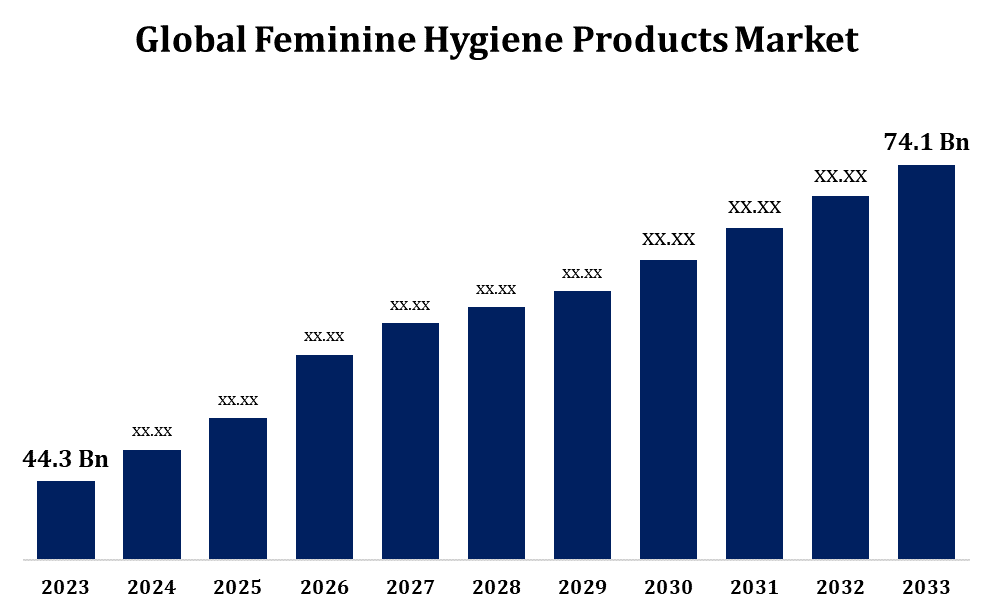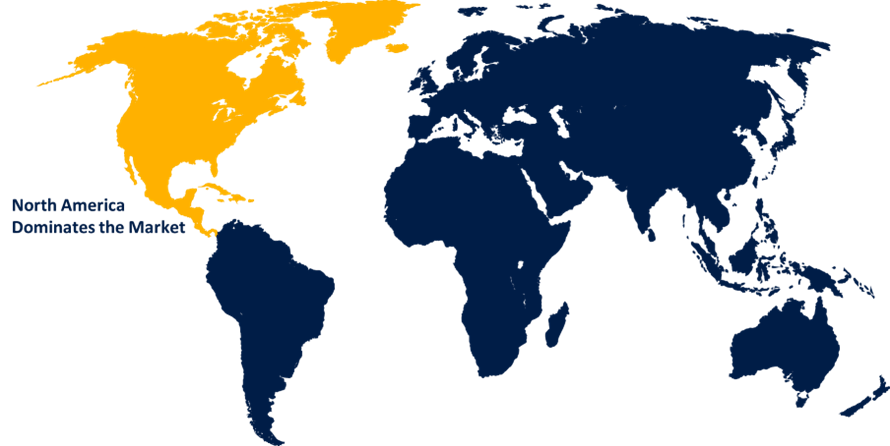Global Feminine Hygiene Products Market Size To Worth USD 74.1 Billion By 2033 | CAGR of 5.28%
Category: Consumer GoodsGlobal Feminine Hygiene Products Market Size To Worth USD 74.1 Billion By 2033
According to a research report published by Spherical Insights & Consulting, the Global Feminine Hygiene Products Market Size to Grow from USD 44.3 Billion in 2023 to USD 74.1 Billion by 2033, at a Compound Annual Growth Rate (CAGR) of 5.28% during the forecast period.

Get more details on this report -
Browse key industry insights spread across 215 pages with 110 Market data tables and figures & charts from the report on the "Global Feminine Hygiene Products Market Size, Share, and COVID-19 Impact Analysis, By Product Type (Menstrual Care Products and Cleaning & Deodorizing Products), By Distribution Channel (Hypermarkets/Supermarkets, Convenience Stores, Drugs Stores, and Others), and By Region (North America, Europe, Asia-Pacific, Latin America, Middle East, and Africa), Analysis and Forecast 2023 - 2033." Get Detailed Report Description Here:https://www.sphericalinsights.com/reports/feminine-hygiene-products-market
The feminine hygiene products market is experiencing robust growth, fueled by rising awareness of menstrual health and hygiene, particularly in emerging economies. With more women joining the workforce and a growing focus on personal wellness, there is an increased demand for products like sanitary pads, tampons, and menstrual cups. Governmental and non-governmental initiatives supporting menstrual hygiene are further boosting the market. Innovations, including organic and biodegradable options, signal a shift toward sustainability. However, cultural taboos and limited access in rural areas continue to pose challenges. Major brands are expanding their product lines with eco-friendly, skin-safe alternatives, while direct-to-consumer brands are gaining momentum online. Consequently, the global feminine hygiene market is expected to grow steadily, catering to a diverse, health-conscious consumer base.
Feminine Hygiene Products Market Value Chain Analysis
The value chain of the feminine hygiene products market includes raw material suppliers, manufacturers, distributors, retailers, and end consumers. Raw materials such as cotton, synthetic fibers, and absorbent gels are sourced for production, with a growing preference for organic and biodegradable options to meet eco-friendly demands. Manufacturers design, produce, and package products like sanitary pads, tampons, menstrual cups, and panty liners, incorporating innovations for better comfort and sustainability. These products are then distributed through various channels, including wholesalers, online platforms, pharmacies, and supermarkets, to expand their reach. Retailers play a vital role in ensuring product visibility and accessibility. The value chain culminates with consumers, who are increasingly prioritizing quality, affordability, and sustainability. Key players focus on product differentiation and efficient supply chains to meet the changing expectations of a diverse, global customer base.
Feminine Hygiene Products Market Opportunity Analysis
The feminine hygiene products market offers substantial growth opportunities, especially through innovations in eco-friendly and sustainable solutions. As environmental awareness grows, demand for biodegradable and reusable products like organic cotton pads and menstrual cups is rising, appealing to sustainability-conscious consumers. Additionally, urbanization and increasing female workforce participation in emerging markets are fueling the need for convenient and discreet options. Expanding into underserved rural areas presents further potential, with educational campaigns and government initiatives driving menstrual health awareness and encouraging product adoption. Digital marketing and e-commerce are enabling direct-to-consumer sales, allowing niche brands to reach global markets. Health-focused product variations, such as hypoallergenic and fragrance-free options, address sensitive skin concerns, further broadening the market. Together, these trends are generating new opportunities across both developed and developing regions.
The growing awareness of menstrual health is significantly driving the expansion of the feminine hygiene products market, as increased menstrual literacy promotes product adoption and reduces stigma. Educational initiatives, spearheaded by NGOs, governments, and social media influencers, are helping to normalize conversations about menstruation, particularly in underserved regions. This rise in awareness is motivating young women to seek safe, high-quality menstrual products, broadening the market's reach. Greater access to information empowers consumers to make informed decisions, leading to higher demand for innovative, health-conscious products, such as organic, chemical-free, and biodegradable options. Schools and workplaces are also becoming more supportive by providing sanitary products and facilities, further driving adoption. As education and awareness continue to grow, the demand for diverse menstrual care solutions is expected to rise, fueling global market growth and product diversification.
The feminine hygiene products market faces several challenges, including cultural stigma, affordability, and environmental concerns. In many regions, menstruation remains a taboo topic, hindering open discussions and education about hygiene options. This lack of awareness impacts product adoption and limits access, particularly in rural and low-income areas. Affordability is another major obstacle, as high-quality products can be expensive, making them out of reach for economically disadvantaged women and girls. Additionally, conventional sanitary products contribute to environmental waste, as single-use pads and tampons often contain non-biodegradable plastics, posing disposal challenges. Overcoming these barriers requires not only the development of innovative, eco-friendly, and affordable alternatives but also continued educational initiatives, policy reforms, and subsidies to ensure that feminine hygiene products are accessible and accepted globally.
Insights by Product Type
The menstrual care products segment accounted for the largest market share over the forecast period 2023 to 2033. Products like sanitary pads, tampons, and menstrual cups remain dominant in the market, but emerging trends are shifting towards eco-friendly and health-conscious alternatives. There is an increasing demand for organic cotton, biodegradable, and chemical-free products as consumers prioritize sustainability and skin sensitivity. Reusable options, such as menstrual cups and washable pads, are gaining traction for their cost-effectiveness and environmental benefits. As menstrual literacy rises, more consumers are exploring various products that align with their comfort and lifestyle preferences. E-commerce platforms play a key role in expanding access to diverse brands, while educational initiatives help normalize the use of these products, especially in underserved regions, driving the continuous global growth of the segment.
Insights by Distribution Channel
The hypermarkets/supermarket segment accounted for the largest market share over the forecast period 2023 to 2033. The hypermarket and supermarket segment is vital to the growth of the feminine hygiene products market, providing consumers with easy access and convenience. These retail channels offer ample shelf space and strategic product placement, boosting the visibility of sanitary pads, tampons, menstrual cups, and other menstrual care products, thereby reaching a wide customer base. Many consumers prefer shopping in-store, as it allows them to physically inspect products, compare options, and take advantage of discounts or bundled deals. Additionally, major retailers are responding to the demand for sustainable products by stocking organic and eco-friendly menstrual care items. In emerging markets, the expansion of hypermarkets and supermarkets into suburban and rural areas further extends product reach, driving market growth and promoting the wider adoption of menstrual care products.
Insights by Region

Get more details on this report -
North America is anticipated to dominate the Feminine Hygiene Products Market from 2023 to 2033. In the U.S. and Canada, awareness of menstrual health is widespread, with consumers increasingly seeking products that emphasize comfort, health, and environmental sustainability. This demand has led to the growth of organic and biodegradable options, such as reusable menstrual cups, organic tampons, and cotton-based pads. The strong presence of major brands, coupled with a well-established retail network and the expansion of e-commerce platforms, ensures broad accessibility. Additionally, supportive policies, like tax exemptions on menstrual products, make these hygiene products more affordable, further stimulating market growth. In this mature market, there is also a rising trend toward health-focused product customization, catering to various skin sensitivities and preferences, which drives continued product diversification and market expansion.
Asia Pacific is witnessing the fastest market growth between 2023 to 2033. In countries like India, China, and Indonesia, growing education around menstrual health, supported by NGOs and government initiatives, is helping reduce stigma and encouraging greater product adoption. Economic growth in these regions has boosted women's purchasing power, increasing demand for high-quality hygiene products. However, affordability remains a significant barrier, particularly in rural areas, highlighting the need for cost-effective solutions. The market is witnessing a rise in biodegradable and reusable products to address environmental concerns. With the growth of e-commerce, consumers now have greater access to a variety of products. Both local and global brands are focusing on innovations that cater to cultural preferences and affordability, driving further market expansion in this diverse and rapidly evolving region.
Recent Market Developments
- On January 2024, Compass Diversified (CODI), a publicly traded company, invested USD 380 million to acquire The Honey Pot Company, a feminine care brand headquartered in Atlanta, U.S., which is available in over 33,000 retail stores across the country. This partnership will help the brand broaden its product reach throughout the United States.
Major players in the market
- Edgewell Personal Care Company
- First Quality Enterprises
- Incorporation
- Hengan International Group Co. Limited
- Johnson & Johnson
- Kao Corporation
- Kimberly-Clark Corporation
- Procter & Gamble Company
- Svenska Cellulosa Aktiebolaget
- Unicharm Corporation and Unilever plc
Market Segmentation
This study forecasts revenue at global, regional, and country levels from 2023 to 2033.
Feminine Hygiene Products Market, Product Type Analysis
- Menstrual Care Products
- Cleaning & Deodorizing Products
Feminine Hygiene Products Market, Distribution Channel Analysis
- Hypermarkets/Supermarkets
- Convenience Stores
- Drugs Stores
- Others
Feminine Hygiene Products Market, Regional Analysis
- North America
- US
- Canada
- Mexico
- Europe
- Germany
- Uk
- France
- Italy
- Spain
- Russia
- Rest of Europe
- Asia Pacific
- China
- Japan
- India
- South Korea
- Australia
- Rest of Asia Pacific
- South America
- Brazil
- Argentina
- Rest of South America
- Middle East & Africa
- UAE
- Saudi Arabia
- Qatar
- South Africa
- Rest of the Middle East & Africa
About the Spherical Insights & Consulting
Spherical Insights & Consulting is a market research and consulting firm which provides actionable market research study, quantitative forecasting and trends analysis provides forward-looking insight especially designed for decision makers and aids ROI.
Which is catering to different industry such as financial sectors, industrial sectors, government organizations, universities, non-profits and corporations. The company's mission is to work with businesses to achieve business objectives and maintain strategic improvements.
CONTACT US:
For More Information on Your Target Market, Please Contact Us Below:
Phone: +1 303 800 4326 (the U.S.)
Phone: +91 90289 24100 (APAC)
Email: inquiry@sphericalinsights.com, sales@sphericalinsights.com
Contact Us: https://www.sphericalinsights.com/contact-us
Need help to buy this report?